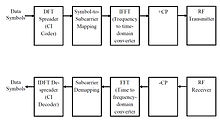This article has multiple issues. Please help improve it or discuss these issues on the talk page. (Learn how and when to remove these messages)
|
Carrier Interferometry (CI) is a spread spectrum scheme designed to be used in an Orthogonal Frequency-Division Multiplexing (OFDM) communication system for multiplexing and multiple access, enabling the system to support multiple users at the same time over the same frequency band.
Like MC-CDMA, CI-OFDM spreads each data symbol in the frequency domain. That is, each data symbol is carried over multiple OFDM subcarriers. But unlike MC-CDMA, which uses binary-phase Hadamard codes (code values of 0 or 180 degrees) or binary pseudonoise, CI codes are complex-valued orthogonal codes. In the simplest case, CI code values are coefficients of a discrete Fourier transform (DFT) matrix. Each row or column of the DFT matrix provides an orthogonal CI spreading code which spreads a data symbol. Spreading is achieved by multiplying a vector of data symbols by the DFT matrix to produce a vector of coded data symbols, then each coded data symbol is mapped to an OFDM subcarrier via an input bin of an inverse fast Fourier transform (IFFT). A block of contiguous subcarriers may be selected, or to achieve better frequency diversity, non-contiguous subcarriers distributed over a wide frequency band can be used. A guard interval, such as a cyclic prefix (CP), is added to the baseband CI-OFDM signal before the signal is processed by a radio front-end to convert it to an RF signal, which is then transmitted by an antenna.
A significant advantage of CI-OFDM over other OFDM techniques is that CI spreading shapes the time-domain characteristics of the transmitted waveform. Thus, CI-OFDM signals have a much lower peak-to-average-power ratio (PAPR), or crest factor, compared to other types of OFDM.[1] This greatly improves power efficiency and reduces the cost of power amplifiers used in the radio transmitter.
A CI-OFDM receiver removes the cyclic prefix from a received CI-OFDM transmission and performs OFDM demodulation with a DFT (e.g., an FFT) typically used in OFDM receivers. The CI-spread symbol values are collected from their respective subcarriers in an inverse-mapping process and may be equalized to compensate for multipath fading or processed for spatial demultiplexing. The CI de-spreader performs an inverse-DFT on the spread symbols to recover the original data symbols.

Since CI coding can shape the time-domain characteristics of the transmitted waveform, it can be used to synthesize various waveforms, such as direct-sequence spread spectrum[2] and frequency shift key[3] [4] signals. The advantage is that the receiver can select time-domain or frequency-domain equalization based on how much scattering occurs in the transmission channel. For rich scattering environments, frequency-domain equalization using FFTs requires less computation than conventional time-domain equalization and performs substantially better.
- ^ Multi-Carrier Technologies for Wireless Communication (2002 ed.). Stanford, Calif: Springer. 2001-11-30. ISBN 9780804725071.
- ^ Zhiqiang Wu; Nassar, C.; Shattil, S. (2001). "Ultra wideband DS-CDMA via innovations in chip shaping". IEEE 54th Vehicular Technology Conference. VTC Fall 2001. Proceedings (Cat. No.01CH37211). Vol. 4. pp. 2470–2474. doi:10.1109/VTC.2001.957194. ISBN 978-0-7803-7005-0. S2CID 28052623.
- ^ Natarajan, B.; Nassar, C.R.; Shattil, S. (2001). "Enhanced Bluetooth and IEEE 802.11 (FH) via multi-carrier implementation of the physical layer". 2001 IEEE Emerging Technologies Symposium on Broad Band Communications for the Internet Era. Symposium Digest (Cat. No.01EX508). pp. 129–133. doi:10.1109/ETS.2001.979440. ISBN 978-0-7803-7161-3. S2CID 16077120.
